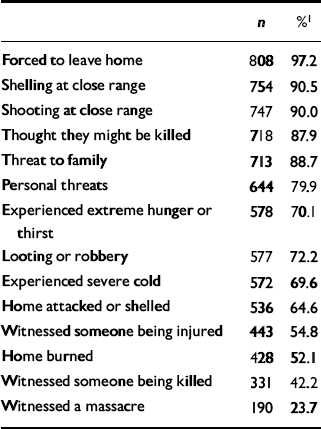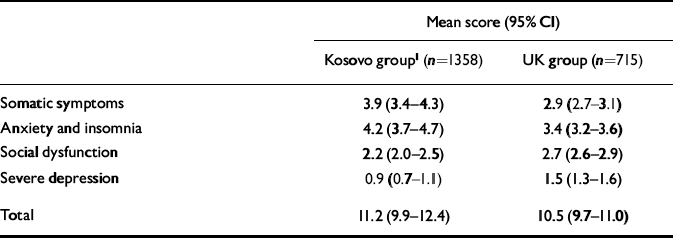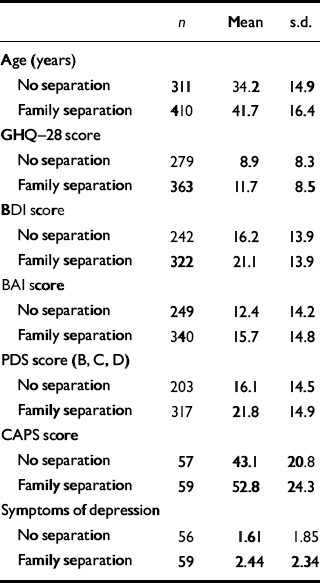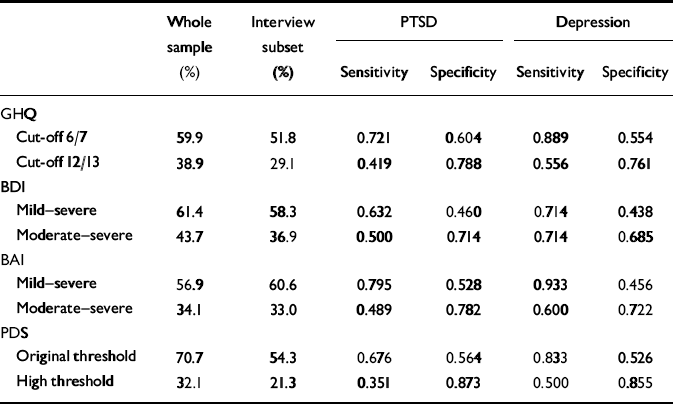During the summer of 1999 the UK received 4346 refugees from Kosovo in a programme coordinated by the United Nations High Commission for Refugees (UNHCR). In response, the UK Department of Health set out to assess their probable health needs. Available evidence suggested that mental health was likely to be their most important health problem. However, an initial general health assessment undertaken by most UK health authorities did not seem to demonstrate many overt psychiatric problems. It became apparent that there was no ideal scale with which to undertake these screening assessments. This study was established first to assess the prevalence of mental health problems in this population using both self-report and interview measures, and second, to develop a package of suitable validated questions for use by public health departments who receive refugees in the future. This paper addresses the first of these objectives.
METHOD
Study setting and design
The study was a large-scale, non-randomised epidemiological survey of Kosovan refugees accepted under the UN programme into the UK. One of us (L.S.) visited 26 reception centres in the north of England, in which Kosovan refugees had been placed, and invited the residents to complete our questionnaires (November 1999 to January 2000). We aimed to collect data from as many people as possible. It was not possible to compare those who chose to complete the questionnaires with those who declined.
Self-report measures
A questionnaire pack was developed using Kosovan Albanian forms (developed for this study) of the War Trauma Questionnaire (Reference MacksoudMacksoud, 1992), the Beck Depression Inventory (BDI; Reference BeckBeck, 1996), the Beck Anxiety Inventory (BAI; Reference BeckBeck, 1987), the 28-item General Health Questionnaire (GHQ—28; Reference Goldberg and HillierGoldberg & Hillier, 1979) and the Post-traumatic Diagnostic Scale (PDS; Reference Foa, Cashman and JaycoxFoa et al, 1997). Each measure was translated and then back-translated to ensure that it was a reasonable equivalent of the original. Where necessary, the self-report questionnaires were read aloud (in Albanian) to respondents.
Interview validation
A subgroup of people who had completed the questionnaires were approached subsequently and interview assessments were undertaken (February 2000 to June 2000). All interviews were conducted in Albanian by one of us (L.S.) using the Clinician Administered PTSD (post-traumatic stress disorder) Scale (CAPS) for DSM—IV (Reference Blake, Weathers and NagyBlake et al, 1997) and a symptom list for major depressive disorder as defined in the DSM—IV (American Psychiatric Association, 1994). The interview subgroup was recruited from five of the reception centres. As many refugees as possible were included from each of these centres. The reception centres were selected on the basis that they included people with a broad range of scores in the self-report survey, so that sensitivity and specificity analyses could be undertaken.
Statistical analyses
Statistical analyses were undertaken using the Statistical Package for the Social Sciences, version 9 for Windows.
RESULTS
Characteristics of the sample
A total of 842 adult refugees agreed to undertake the questionnaire assessment, although not all participants completed all the items. Scrutinising the data shows that it is possible that a few refugees filled in a second form for their spouse. The mean age was 38.1 (s.d.=16.1) years (n=806), with 52.9% women and 47.1% men (n=831). The majority were married (569; 70.4%); 206 were single (24.5%) and 33 widowed (3.9%). Nearly half had completed high-school education (385; 47.8%). Of the remainder, 89 (11%) had had no school education, 201 (24.9%) had completed primary education and 131 (16.2%) had had education at university level. Participants reported a wide variety of traumatic experiences (Table 1). Almost all reported that they had been forced to leave home (on average 2.5 times, s.d.=1.4; n=702). Shelling and shootings were commonly recorded and nearly 88% reported having been in a situation in which they thought they might have been killed.
Table 1 Experiences in Kosovo reported by a group of 842 adult Kosovan Albanian refugees

| n | %1 | |
|---|---|---|
| Forced to leave home | 808 | 97.2 |
| Shelling at close range | 754 | 90.5 |
| Shooting at close range | 747 | 90.0 |
| Thought they might be killed | 718 | 87.9 |
| Threat to family | 713 | 88.7 |
| Personal threats | 644 | 79.9 |
| Experienced extreme hunger or thirst | 578 | 70.1 |
| Looting or robbery | 577 | 72.2 |
| Experienced severe cold | 572 | 69.6 |
| Home attacked or shelled | 536 | 64.6 |
| Witnessed someone being injured | 443 | 54.8 |
| Home burned | 428 | 52.1 |
| Witnessed someone being killed | 331 | 42.2 |
| Witnessed a massacre | 190 | 23.7 |
General Health Questionnaire
The mean total score on the translated GHQ—28 (using the GHQ scoring method of 0, 0, 1, 1) was 10.37 (s.d.=8.47; n=715). The currently recommended cut-off point for a positive result is a total score of 7 or more (Reference Goldberg, Gater and SartoriusGoldberg et al, 1997). Using this criterion, 428 (59.9%) were above threshold (n=715). In a previous report (Reference Easton and TurnerEaston & Turner, 1991) a much more conservative threshold has been suggested for traumatised people, with a cut-off between 12 and 13 (Reference Turner and LeeTurner & Lee, 1998). Even using this approach, 278 (38.9%) were still above the threshold for caseness.
The 28-item version of the GHQ yields sub-scale scores in four domains: (A) somatic symptoms, (B) anxiety and insomnia, (C) social dysfunction and (D) severe depression. We were fortuitously able to compare our data on the GHQ and its sub-scales with a recently published large survey of Kosovan Albanians who had stayed in Kosovo, or who had been displaced to nearby countries and had quickly returned to live in Kosovo (Reference Lopes Cardozo, Vergara and AganiLopes Cardozo et al, 2000). The total GHQ—28 scores from the different samples were similar, but there were interesting differences in the detailed sub-scale scores (Table 2). Those who had remained in or who had already returned to Kosovo reported higher levels of somatic symptoms as well as anxiety and insomnia (sub-scales A and B). On the other hand, levels of social dysfunction and severe depression (substantially to do with suicidal thinking) were higher in the refugee sample in the UK (sub-scales C and D).
Table 2 Comparison of responses to the 28-item General Health Questionnaire by two groups of Kosovan Albanians, one in Kosovo and the other living as refugees in the UK

| Mean score (95% CI) | ||
|---|---|---|
| Kosovo group1 (n=1358) | UK group (n=715) | |
| Somatic symptoms | 3.9 (3.4-4.3) | 2.9 (2.7-3.1) |
| Anxiety and insomnia | 4.2 (3.7-4.7) | 3.4 (3.2-3.6) |
| Social dysfunction | 2.2 (2.0-2.5) | 2.7 (2.6-2.9) |
| Severe depression | 0.9 (0.7-1.1) | 1.5 (1.3-1.6) |
| Total | 11.2 (9.9-12.4) | 10.5 (9.7-11.0) |
Beck Depression Inventory
The mean score on the translated version of the BDI was 18.89 (s.d.=14.18; n=617). Comparison with the severity ranges for the standardised (English) BDI revealed that 238 (38.6%) were below threshold (minimal symptoms, scores 0 to 13); 109 (17.7%) were in the mild range (scores 14 to 19); 134 (21.7%) were in the moderate range (scores 20 to 28); and 136 (22.0%) were in the severe range (scores 29 and above). Using these thresholds, 61.4% have a score indicating possible depression and 43.7% have scores in the moderate or severe range.
Beck Anxiety Inventory
The mean score on the translated version of the BAI was 14.09 (s.d.=14.50; n=645). Again, it is possible to apply ranges to these scores from the standardised (English) scale: 278 (43.1%) had scores between 0 and 7, said to reflect minimal anxiety; 147 (22.8%) had scores in the mild range (8 to 15); 103 (16.0%) had scores in the moderate range (16 to 25); and 117 (18.1%) had scores in the severe range (26 and above). Using these thresholds, 56.9% have a score indicative of possible anxiety and 34.1% have a score suggesting moderate or severe anxiety.
Post-traumatic Diagnostic Scale
The response to the translated version of the PDS (which was towards the end of the questionnaire pack) was lower than for the other measures. The data were scored so that if some but not all items for a given criterion had been marked, then the criterion was included in the analyses. If all the items had been omitted, the criterion was shown as a missing variable. This approach was intended to take account of occasional missing items. The missing values were scored as negative. The effect of this is to reduce the likelihood of achieving diagnosis since individual criteria will be included as negative where, had all the items been marked, the threshold might have been reached.
There was a particularly low response rate to items that dealt with impact of trauma at the time or with duration of symptoms. Only 360 participants gave valid returns to all six criteria. Of these, 234 (65.0%) met the requirements for a probable diagnosis of PTSD based on the (English language) standardised thresholds in this self-report measure. However, in view of the low response rate, a number of other analyses were undertaken. First, criterion A, which deals with history of trauma, was omitted from all analyses (reasonable in view of the information scores elsewhere). With this approach, the valid sample size rose to 457. Of these, 310 (67.8%) were scored as positive. Finally, the symptom criteria (B, C and D) alone were analysed. Here, the sample size rose again, to 639. Of these, 452 (70.7%) were scored as positive. Similar percentages were found therefore, regardless of scoring method.
It has been suggested that the original threshold for scoring the PDS may be too generous, and a more conservative threshold has been proposed (Reference Brewin, Andrews and RoseBrewin et al, 1999). Each of the symptom items is rated by frequency. A threshold of ‘once a week or less/once in a while’ is sufficient for inclusion using the standard scoring approach (Reference Foa, Cashman and JaycoxFoa et al, 1997). Taking a higher standard and requiring that symptoms meet the higher threshold of being present at least ‘two to four times a week/half the time’ lowers the predicted prevalence of PTSD. In this case, using the symptom criteria (B, C and D), only 32.1% scored as positive.
Relationships between questionnaires, age, gender, trauma and current separation
There were significant correlations between age and all scales: GHQ (ρ=0.36, n=689, P<0.001) and PDS total severity score (ρ=0.26, n=555, P<0.001). There was no significant association with gender.
A cumulative variable (exposure to violence) was constructed by summating the main trauma items in the War Trauma Questionnaire. As expected, exposure to violence was significantly and positively correlated with GHQ (ρ=0.30, n=715, P<0.001), BDI total score (ρ=0.32, n=617, P<0.0010, BAI total score (ρ=0.24, n=0.001) and PDS total severity score (ρ=0.33, n=575, P<0.001). There was also a positive relationship between age and exposure to violence (ρ=0.26, n=555, P<0.001).
A categorical variable was constructed on the basis of family separation (present or absent). Significant differences (Table 3) were found for age (Mann—Whitney U=45 738; P<0.001), GHQ (U=40962; P<0.001), BDI (U=30 379; P<0.001), BAI (U=35 213; P<0.001) and PDS (U=24 880; P<0.001). Those with family separations were older and had higher scores on measures of psychopathology.
Table 3 Effects of separation from family

| n | Mean | s.d. | |
|---|---|---|---|
| Age (years) | |||
| No separation | 311 | 34.2 | 14.9 |
| Family separation | 410 | 41.7 | 16.4 |
| GHQ—28 score | |||
| No separation | 279 | 8.9 | 8.3 |
| Family separation | 363 | 11.7 | 8.5 |
| BDI score | |||
| No separation | 242 | 16.2 | 13.9 |
| Family separation | 322 | 21.1 | 13.9 |
| BAI score | |||
| No separation | 249 | 12.4 | 14.2 |
| Family separation | 340 | 15.7 | 14.8 |
| PDS score (B, C, D) | |||
| No separation | 203 | 16.1 | 14.5 |
| Family separation | 317 | 21.8 | 14.9 |
| CAPS score | |||
| No separation | 57 | 43.1 | 20.8 |
| Family separation | 59 | 52.8 | 24.3 |
| Symptoms of depression | |||
| No separation | 56 | 1.61 | 1.85 |
| Family separation | 59 | 2.44 | 2.34 |
Characteristics of the interview subsample
Interviews were undertaken with 120 participants who had already completed the questionnaires. This subgroup was composed of 64 women and 56 men, with a mean age of 37.1 years (s.d.=14.7). There was no significant difference in age or gender between those who were and were not interviewed. Comparison rates of caseness derived from the screening questionnaires have been calculated for this subgroup and are shown in Table 4, where they may be compared with the rates in the whole sample.
Table 4 Psychiatric caseness, sensitivity and specificity

| Whole sample (%) | Interview subset (%) | PTSD | Depression | |||
|---|---|---|---|---|---|---|
| Sensitivity | Specificity | Sensitivity | Specificity | |||
| GHQ | ||||||
| Cut-off 6/7 | 59.9 | 51.8 | 0.721 | 0.604 | 0.889 | 0.554 |
| Cut-off 12/13 | 38.9 | 29.1 | 0.419 | 0.788 | 0.556 | 0.761 |
| BDI | ||||||
| Mild—severe | 61.4 | 58.3 | 0.632 | 0.460 | 0.714 | 0.438 |
| Moderate—severe | 43.7 | 36.9 | 0.500 | 0.714 | 0.714 | 0.685 |
| BAI | ||||||
| Mild—severe | 56.9 | 60.6 | 0.795 | 0.528 | 0.933 | 0.456 |
| Moderate—severe | 34.1 | 33.0 | 0.489 | 0.782 | 0.600 | 0.722 |
| PDS | ||||||
| Original threshold | 70.7 | 54.3 | 0.676 | 0.564 | 0.833 | 0.526 |
| High threshold | 32.1 | 21.3 | 0.351 | 0.873 | 0.500 | 0.855 |
Relationships between questionnaire and clinical diagnosis
Using the standard cut-off criteria on the CAPS interview, 46 (39%; n=118) had a diagnosis of PTSD. The mean CAPS score in this sample was 48.6 (s.d.=21.6; n=120). Using the criteria of DSM—IV and applying these at interview, 19 participants (16%; n=120) met the criteria for a major depressive episode. Examining comorbidity, we found that all but one of the 19 participants with major depressive disorder also had PTSD; on the other hand, only 18 of the 46 with PTSD also had a major depressive disorder. Using standard scoring criteria, in the same subset, questionnaire measures gave much higher estimates than did the interviews: GHQ—28 caseness 52%, BDI depression 58%, BAI anxiety 61% and PDS/PTSD 54%.
In the whole sample, the questionnaire data gave the following percentages: GHQ—28 caseness 60%, BDI depression 61%, BAI anxiety 57% and PDS/PTSD 71%. The subset interviewed was not a random sample of the whole group. The greatest difference in results is in relation to the PTSD scores (PDS scores of 54% v. 71%). This suggests that the prevalence of PTSD in the whole sample would be greater than in the interview subset (PTSD diagnosed in 38%). Adjusting the results on this basis, the proportion of people with an interview diagnosis of PTSD in the whole sample would be expected to be just below 50% (
![]() \batchmode \documentclass[fleqn,10pt,legalpaper]{article} \usepackage{amssymb} \usepackage{amsfonts} \usepackage{amsmath} \pagestyle{empty} \begin{document} \(\frac{71}{54}{\times}38\%\) \end{document}
). This is therefore the best estimate of PTSD diagnosis in the whole sample, based on questionnaire data, adjusted on the basis of an interview validation exercise in a subset.
\batchmode \documentclass[fleqn,10pt,legalpaper]{article} \usepackage{amssymb} \usepackage{amsfonts} \usepackage{amsmath} \pagestyle{empty} \begin{document} \(\frac{71}{54}{\times}38\%\) \end{document}
). This is therefore the best estimate of PTSD diagnosis in the whole sample, based on questionnaire data, adjusted on the basis of an interview validation exercise in a subset.
Sensitivities and specificities for each of the screening questionnaires at two levels of severity are shown in Table 4 in summary form.
DISCUSSION
Mental health of refugees
Refugees are individuals with a well-founded fear of persecution arising from one or more of a number of arbitrary causes and who cannot obtain protection in their own country — typically because it is the regime there that is responsible for the persecution. They may make their own way to safety in a new country or they may become part of an international programme of evacuation, under the auspices of the UNHCR. It has been suggested in an earlier review (Reference Turner and Gorst-UnsworthTurner & Gorst-Unsworth, 1990) that there are four common psychological reactions for which refugees are at high risk: PTSD, related to direct exposure to (often malicious) violence; depression, related to associated loss events; somatisation (for example where physical violence has been used to achieve psychological change); and the ‘existential dilemma’ of the refugee whose core beliefs have been seriously challenged.
Most surveys of refugees have focused on PTSD and depression, probably because these are easier to measure. Large-scale community surveys generally rely on questionnaire (self-report) measures. Of 534 Bosnian refugees living in Croatia (Reference Mollica, McInnes and SarajlicMollica et al, 1999), 39% were reported as having a probable diagnosis of depression and 26% of PTSD defined according to DSM—IV. In 993 Cambodian refugees living in Thailand (Reference Mollica, McInnes and PooleMollica et al, 1998) the corresponding rates were 68% for depression and 37% for PTSD. Thus in general, high rates of PTSD and depression are reported. Interview-based studies tend to present lower figures for the prevalence of these diagnoses (e.g. Reference Hondius, Van Willigen and KleijnHondius et al, 2000). In the UK, Van Velsen et al (Reference Van Velsen, Gorst-Unsworth and Turner1996) in an interview survey of a mixed group of refugees in London reported 35% with depression (major depressive disorder using DSM—III—R; American Psychiatric Association, 1987) and 52% with PTSD, but this was in a group of people specifically referred for specialist psychiatric assessment.
The study reported here demonstrates that a substantial proportion of recently arrived adult refugees have clinically significant mental health problems. We have demonstrated that about half of the total refugees sampled had evidence of PTSD, many with a comorbid major depressive disorder. The time course of PTSD (e.g. Reference Kessler, Sonnega and BrometKessler et al, 1995) is such that some members of this recently arrived refugee community would still be in the natural recovery phase, and the prevalence of PTSD would probably diminish somewhat over the subsequent year or so, leaving a core group with a chronic persistent condition. This may be taken as a sign of the resilience of many who survived this conflict, but it also implies that there is still a substantial need for health care in a proportion.
Validity of self-report measures
This study demonstrates that care is required in extrapolating from self-report measures, using standard scoring approaches, at least in refugee samples. The validity of the self-report questionnaire approach has already been considered by Smith Fawzi et al (Reference Smith Fawzi, Murphy and Pham1997) in a sample of former Vietnamese political prisoners. They found serious problems in seeking to rely on previous standardisation data. They concluded that ‘future community based studies conducted among refugee populations should include a validation sub-study in order to ascertain the most appropriate cut-off score for each individual context’. We agree with this conclusion.
In our survey, more consistent results were obtained using higher thresholds for the self-report measures, but even so the estimated prevalence of depression remained high. This is an important issue, not least because of the tendency of some to reject the diagnostic paradigm in refugee populations. It is just as important not to overstate the prevalence of psychiatric disorders and the need for treatment services as it is to avoid understatements of need. This is especially important when there is a need to prioritise resources between community development work — designed to help the whole refugee community — and treatment services, designed to help the most traumatised subgroups. These are complementary approaches, but are sometimes unfortunately seen as being in opposition.
Comparison between UK and Kosovo data
We were able to compare our data with the results of a large survey of Kosovan Albanians in Kosovo carried out at about the same time (Reference Lopes Cardozo, Vergara and AganiLopes Cardozo et al, 2000). The total GHQ—28 scores from the different samples were similar but there were interesting differences in the detailed subscale scores (see Table 2). These results have face validity. They suggest that Kosovan Albanians who were in Kosovo were probably more frightened. On the other hand, those who found themselves in the UK, although objectively safer — at least for the time being — experienced greater levels of alienation and isolation as well as feelings of despair.
Pro- and post-migration factors
A substantial body of evidence points to the link between (for example) PTSD and the degree of trauma exposure in refugees (Mollica et al, Reference Mollica, McInnes and Poole1998, Reference Mollica, McInnes and Sarajlic1999; Reference Shrestha, Sharma and Van OmmerenShrestha et al, 1998). However, it also appears that there is a cumulative effect, with both pre-migration trauma exposure and post-migration factors being implicated in overall psychiatric morbidity. For example, in the UK, Van Velsen et al (Reference Van Velsen, Gorst-Unsworth and Turner1996) reported a significant relationship between levels of depression and current social context (including poor accommodation, isolation and lack of family reunion). Gorst-Unsworth & Goldenberg (Reference Gorst-Unsworth and Goldenberg1998), in a sample of 84 Iraqi men in London, reported a significant relationship between social factors in exile and the severity both of PTSD and depression; they reported that poor social support was a stronger predictor of depression than were trauma factors. Finally, Steel et al (Reference Steel, Silove and Bird1999), in an Australian sample of Tamil refugees, reported that pre-migration factors accounted for 20% and post-migration factors 14% of the variance in post-traumatic symptoms. So PTSD and depression, often comorbid, appear to have complex relationships with pre-migration violence and post-migration social difficulties. In the present sample, although the measures are more limited, there were demonstrable effects both of prior traumatisation (experience of violence) and of current difficulty (family separation).
Clinical implications
This study demonstrates the resilience of many Kosovan refugees coming to the UK. None the less, a substantial proportion did have evidence of serious psychological difficulties. Newly arrived refugees not only need community support, but also many will have significant mental health problems and will need access to effective treatment services. Screening questionnaires are likely to be helpful, but the thresholds need careful clinical validation. It is probable that mental health problems will constitute the greatest health burden in refugee communities. One of the implications of the study reported here is that family separation is related to severity of distress. There is scope for using psychosocial interventions, especially to reduce levels of depression. These approaches are likely to be synergistic with individual treatment services for those with the more severe psychological reactions to these experiences.
Clinical Implications and Limitations
CLINICAL IMPLICATIONS
-
▪ The study highlights the resilience of many refugees, even after serious trauma.
-
▪ There is a demonstrable need for treatment services to support the significant minority of refugees with mental health problems.
-
▪ Psychosocial interventions can be an important part of the treatment programme.
LIMITATIONS
-
▪ Although such a large community sample is likely to be representative, the sampling procedure was non-random.
-
▪ The study had to be undertaken quickly, after the refugees' arrival but before their return.
-
▪ Cultural avoidance of disclosure of certain forms of assault is possible.
Acknowledgements
We acknowledge the great help and support offered by Dr Elizabeth Scott, Director of Public Health, Dr Veronika Reisig, Leeds Health Authority, by all the staff in the reception centres, and by the refugees themselves.







eLetters
No eLetters have been published for this article.